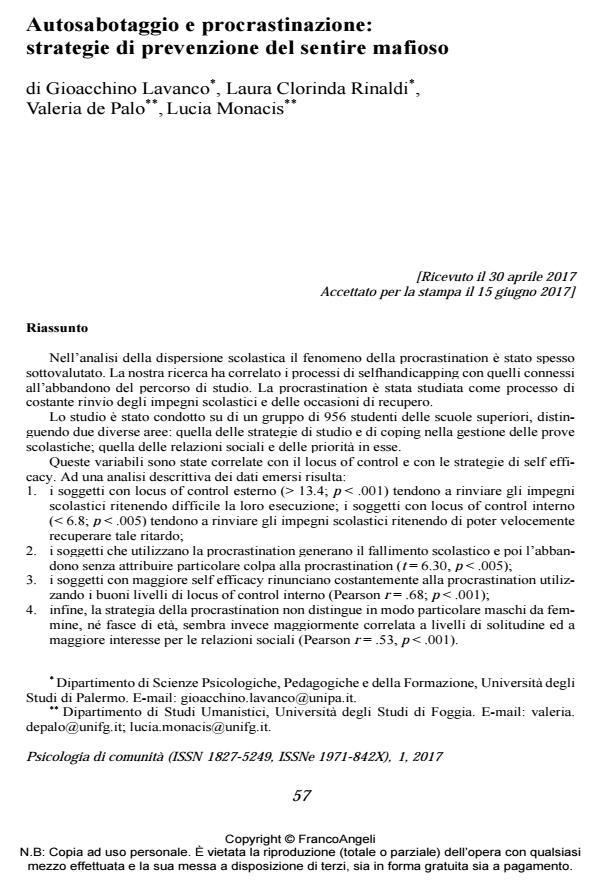Autosabotaggio e procrastinazione: strategie di prevenzione del sentire mafioso
Titolo Rivista PSICOLOGIA DI COMUNITA’
Autori/Curatori Gioacchino Lavanco, Laura Clorinda Rinaldi, Valeria de Palo, Lucia Monacis
Anno di pubblicazione 2017 Fascicolo 2017/1
Lingua Italiano Numero pagine 21 P. 57-77 Dimensione file 257 KB
DOI 10.3280/PSC2017-001006
Il DOI è il codice a barre della proprietà intellettuale: per saperne di più
clicca qui
Qui sotto puoi vedere in anteprima la prima pagina di questo articolo.
Se questo articolo ti interessa, lo puoi acquistare (e scaricare in formato pdf) seguendo le facili indicazioni per acquistare il download credit. Acquista Download Credits per scaricare questo Articolo in formato PDF

FrancoAngeli è membro della Publishers International Linking Association, Inc (PILA)associazione indipendente e non profit per facilitare (attraverso i servizi tecnologici implementati da CrossRef.org) l’accesso degli studiosi ai contenuti digitali nelle pubblicazioni professionali e scientifiche
Nell’analisi della dispersione scolastica il fenomeno della procrastination è stato spesso sottovalutato. La nostra ricerca ha correlato i processi di selfhandicapping con quelli connessi all’abbandono del percorso di studio. La procrastination è stata studiata come processo di costante rinvio degli impegni scolastici e delle occasioni di recupero. Lo studio è stato condotto su di un gruppo di 956 studenti delle scuole superiori, distinguendo due diverse aree: quella delle strategie di studio e di coping nella gestione delle prove scolastiche; quella delle relazioni sociali e delle priorità in esse. Queste variabili sono state correlate con il locus of control e con le strategie di self efficacy. Ad una analisi descrittiva dei dati emersi risulta: 1- I soggetti con locus of control esterno (> 13.4; p < .001) tendono a rinviare gli impegni scolastici ritenendo difficile la loro esecuzione; i soggetti con locus of control interno (< 6.8; p < .005) tendono a rinviare gli impegni scolastici ritenendo di poter velocemente recuperare tale ritardo; 2 - I soggetti che utilizzano la procrastination generano il fallimento scolastico e poi l’abbandono senza attribuire particolare colpa alla procrastination (t = 6.30, p < .005); 3 - I soggetti con maggiore self efficacy rinunciano costantemente alla procrastination utilizzando i buoni livelli di locus of control interno (Pearson r = .68; p < .001); 4 - Infine, la strategia della procrastination non distingue in modo particolare maschi da femmine, né fasce di età, sembra invece maggiormente correlata a livelli di solitudine ed a maggiore interesse per le relazioni sociali (Pearson r = .53, p < .001). Per le strategie di intervento è stato verificato che i soggetti con gruppi supportivi di pari tendono a non utilizzare la procrastination, mentre i soggetti maggiormente isolati utilizzano la procrastination in condizioni di malinconia e di conflitto. Poiché la procrastination è un fattore predittivo del selfhandicapping sarà necessario all’interno della scuola lavorare alla formazione degli insegnanti per la prevenzione della procrastination scolastica.
Parole chiave:Auto fallimento, dispersione, procrastinazione, insuccesso scolastico
Gioacchino Lavanco, Laura Clorinda Rinaldi, Valeria de Palo, Lucia Monacis, Autosabotaggio e procrastinazione: strategie di prevenzione del sentire mafioso in "PSICOLOGIA DI COMUNITA’" 1/2017, pp 57-77, DOI: 10.3280/PSC2017-001006